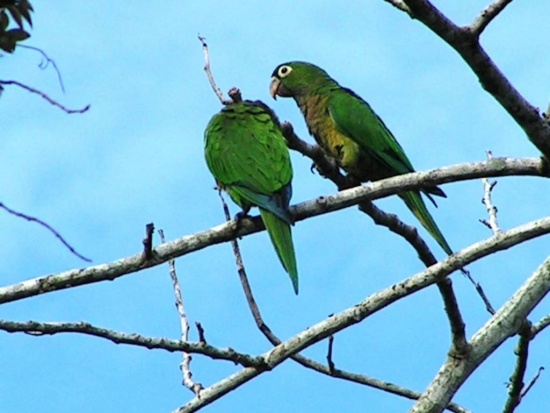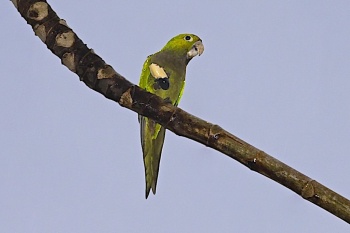m |
m |
||
| (9 intermediate revisions by 5 users not shown) | |||
| Line 1: | Line 1: | ||
| − | + | [[Image:Olive-throated_Parakeet.jpg|thumb|550px|right|Subspecies ''astec''<br />Photo by {{user|Carlos+B|Carlos B}} <br /> [[Tortuguero National Park]], [[Costa Rica]], July 2006]] | |
| − | [[Image:Olive-throated_Parakeet.jpg|thumb|550px|right|Photo by Carlos B]] | + | ;[[: Category:Aratinga|Aratinga]] nana |
| + | '''Includes Aztec Parakeet''' | ||
==Identification== | ==Identification== | ||
| − | + | 30cm | |
| + | *Green head, back and tail | ||
| + | *Olive throat and upper breast | ||
| + | *Orange eyes | ||
| + | *Bare cream skin around the eye | ||
| + | :*Younger birds tend to have dark irises | ||
| + | *Olive lower body | ||
| + | *Grey feet<br /> | ||
| + | ==Distribution== | ||
| + | [[Image:Olive-throated_Parakeet_Portland_Jamaica_by_Stanley_Jones.jpg|thumb|350px|right|Subspecies ''nana''<br />Photo by {{user|Stanley+Jones|Stanley Jones}} <br /> Ecclesdown Road , [[Jamaica]] November 2010]] | ||
| − | + | [[Jamaica]], and the Caribbean slope of [[Mexico]] through [[Central America]] to extreme western Panama where it may even be irregular. Can be found as feral in other places including e.g., [[St. Thomas]] and the [[Dominican Republic]]. | |
| + | ==Taxonomy== | ||
| + | ====Subspecies==== | ||
| + | Three subspecies are recognized<sup>[[#References|[1]]]</sup>: | ||
| + | *''A.n. nana'' is native to [[Jamaica]] | ||
| + | *''A.n vicinalis'' is found in north-east [[Mexico]] | ||
| + | *''A.n astec'' is found from south-east Mexico to [[Costa Rica]]/western [[Panama]] | ||
| − | + | The last two subspecies were named Aztec Parakeet in Howell and Webb.<br /> | |
| − | + | The Jamaican subspecies has in the past been considered a separate species from the Central American birds.<br /> | |
| − | + | Placed in genus ''[[: Category:Eupsittula|Eupsittula]]'' by Gill and Donsker. | |
==Habitat== | ==Habitat== | ||
| + | Forest edges and other semi-open areas, but also feeding on crops, causing conflict with local farmers. | ||
==Behaviour== | ==Behaviour== | ||
| − | + | ====Breeding==== | |
| − | + | They nest in termite holes and lay 3-5 eggs which hatch in 26- 27 days. They fledge about 50 days later. | |
| − | + | ====Diet==== | |
| − | + | Diet includes fruits, vegetables and tree buds and agricultural crops. Feeding often occurs in flocks. | |
| − | + | ==References== | |
| − | + | #{{Ref-Clements6thAug11}}# Howell & Webb, 1995. A guide to the birds of Mexico and northern Central America. Oxford University Press. ISBN 0198540124 | |
| − | + | #ambergriscaye.com | |
| − | + | {{ref}} | |
| − | |||
==External Links== | ==External Links== | ||
| − | {{GSearch| | + | {{GSearch|Aratinga_nana}} |
| − | [[Category:Birds]] | + | [[Category:Birds]] [[Category:Aratinga]] |
Revision as of 17:12, 1 October 2013
- Aratinga nana
Includes Aztec Parakeet
Identification
30cm
- Green head, back and tail
- Olive throat and upper breast
- Orange eyes
- Bare cream skin around the eye
- Younger birds tend to have dark irises
- Olive lower body
- Grey feet
Distribution
Jamaica, and the Caribbean slope of Mexico through Central America to extreme western Panama where it may even be irregular. Can be found as feral in other places including e.g., St. Thomas and the Dominican Republic.
Taxonomy
Subspecies
Three subspecies are recognized[1]:
- A.n. nana is native to Jamaica
- A.n vicinalis is found in north-east Mexico
- A.n astec is found from south-east Mexico to Costa Rica/western Panama
The last two subspecies were named Aztec Parakeet in Howell and Webb.
The Jamaican subspecies has in the past been considered a separate species from the Central American birds.
Placed in genus Eupsittula by Gill and Donsker.
Habitat
Forest edges and other semi-open areas, but also feeding on crops, causing conflict with local farmers.
Behaviour
Breeding
They nest in termite holes and lay 3-5 eggs which hatch in 26- 27 days. They fledge about 50 days later.
Diet
Diet includes fruits, vegetables and tree buds and agricultural crops. Feeding often occurs in flocks.
References
- Clements, JF. 2011. The Clements Checklist of Birds of the World. 6th ed., with updates to August 2011. Ithaca: Cornell Univ. Press. ISBN 978-0801445019. Spreadsheet available at http://www.birds.cornell.edu/clementschecklist/downloadable-clements-checklist
- Howell & Webb, 1995. A guide to the birds of Mexico and northern Central America. Oxford University Press. ISBN 0198540124
- ambergriscaye.com
Recommended Citation
- BirdForum Opus contributors. (2024) Olive-throated Parakeet. In: BirdForum, the forum for wild birds and birding. Retrieved 25 April 2024 from https://www.birdforum.net/opus/Olive-throated_Parakeet





